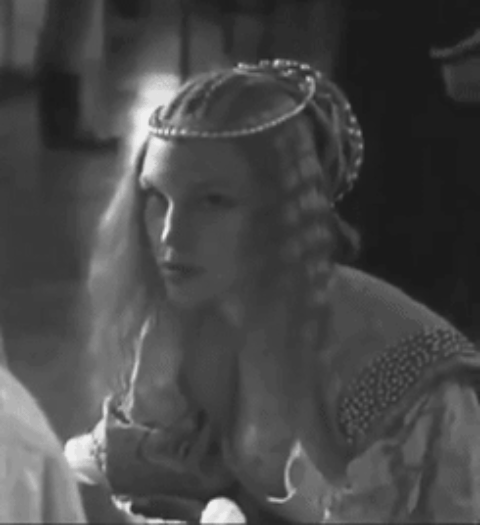catalina-de-aragon: Third part Juana of Aragon, Queen of Naples Juana of Aragon tried to make a new
catalina-de-aragon:Third partJuana of Aragon, Queen of NaplesJuana of Aragon tried to make a new marriage between her daughter Giovanna and Ferdinand, Duke of Calabria, eldest son of King Frederick and heir to the throne, but the King raised a number of issues such as dowry and the inconvenience of a marriage between relatives. Juana and her brother Ferdinand the Catholic showed a great disappointment by the reluctance of the Neapolitan monarch. Meanwhile, two serious duels beat King Ferdinand of Aragon and his wife Isabella of Castile: the deaths of their children, Prince John and Princess Isabella, Queen consort of Portugal. Dating back to the second half of 1498 the intention of Juana of Aragon to travel to Spain to console her brother and her sister-in-law for their losses, as she herself wrote, on 16 September 1498, the Count of Marigliano, Alberico Carafa. King Frederick openly manifestated his discontent in regards to the trip that his stepmother wanted to take.In order to finance the trip, Juana of Aragon had to rid herself of some of her possessions, impose an exceptional donation in her dominions, borrow money and pawn some of her jewels. Ludovico Sforza, byname The Moor, gave her two Genoese ships for the trip.Queen Juana, accompanied by Cardinal Luigi d'Aragona and a large entourage, finally sailed from Naples in September 1499. After she arrived into Barcelona, Juana went to Guadix in order to meet her brother Ferdinand the Catholic. Afterwards the two siblings went to Granada where they spent the whole October and the first half of November. Her daughter arrived a few years later.King Ferdinand installed his sister and his niece in Valencia. In prosperous and productive atmosphere of the city of Turia River in the first years of the 16th century, under the care and direction of a remarkable nobleman of the native aristocracy, Luis Pardo Carroz de Vilaragut, a literary court was developed, where the poems of the gallants had to accompany the ladies-in-waiting of the two Queens of Naples during the festive evenings. Also during this stay, Queen Juana showed her diplomatic virtues as lieutenant of her brother in Aragon.Louis XII of France once master of Milan hurried on his preparations against Naples. The only opponent who was likely to be formidable was Ferdinand the Catholic. He had helped to restore the Aragonese dynasty after the retreat of Charles VIII, and might well put in his claim, if the illegitimate branch of his house were to be excluded. In November 1500 Louis XII of France and Ferdinand of Aragon signed the secret Treaty of Granada, by which they agreed to oust Frederick and divide the kingdom of Naples between them. An excuse was found in the alliance which Frederick in his distress had made with the Ottoman sultan. In Naples it was believed that the main advisor of the agreement had been Juana himself.Unable to resist these mighty powers, Frederick sought refuge in France. The agreement soon fell apart and, over the next several years, Ferdinand’s great general Gonzalo Fernández de Córdoba fought to take Naples from the French, finally succeeding by 1504.Giovanna of Naples was suggested as a potential bride of King Henry VII of England by her aunt Isabella I of Castile. Henry sent three envoys to Valencia in 1505 to report on the physical qualities of the prospective bride. The report on Giovanna’s appearance was satisfactory, but the marriage negotiations failed for political and financial reasons, When Ferdinand of Aragon and his second wife Germaine de Foix left the Iberian Peninsula for Naples in 1506, Juana and her daughter went with him. She chose to remain in her adopted home when her brother returned to Spain. Juana was named Lieutenant General of the kingdom until the arrival of the new viceroy, Ramón de Cardona. Juana and Giovanna lived in Castel Nuovo, Castel Capuano and the Sanseverino palace. They was honored as queens and surrounded by a magnificent court. Beside them the Queen Dowager of Hungary, Beatrice of Aragon, the Duchess Dowager of Milan, Isabella of Aragon, and her daughter Bona Sforza. In 1510 King Ferdinand tried to unite in marriage to his niece Giovanna of Naples with Charles III of Savoy, but this union did not take place. Juana of Aragon died following a short illness on 9 January 1517. A contemporary poet said she was dolce, benegna, morigera, fidel, non importuna… She was buried in the Church of Santa Maria “la Nova”. Her daughter died the following year from the same illness. Giovanna, covered with the Franciscan habit, was buried in the church of San Domenico Maggiore.(X)Sources:http://www.treccani.it/enciclopedia/giovanna-d-aragona-regina-di-napoli_(Dizionario-Biografico)/http://theborgias.wikifoundry.com/page/The+House+of+Aragon+(Naples)https://www.mirrorservice.org/sites/gutenberg.org/4/2/0/2/42025/42025-h/42025-h.htmhttp://www.academia.edu/1171920/I_LUOGHI_DEL_POTERE_DELLA_TRISTE_REYNA_GIOVANNA_III_INFANTA_DELLA_REAL_CASA_D_ARAGONA_REGINA_DI_SICILIA_E_GERUSALEMMEhttp://www.academia.edu/375804/Marina_de_Arag%C3%B3n_la_Sin_Ventura_Princesa_de_Salerno_la_m%C3%A1s_bella_dama_de_los_cancioneros_castellanos -- source link
#history#queens


